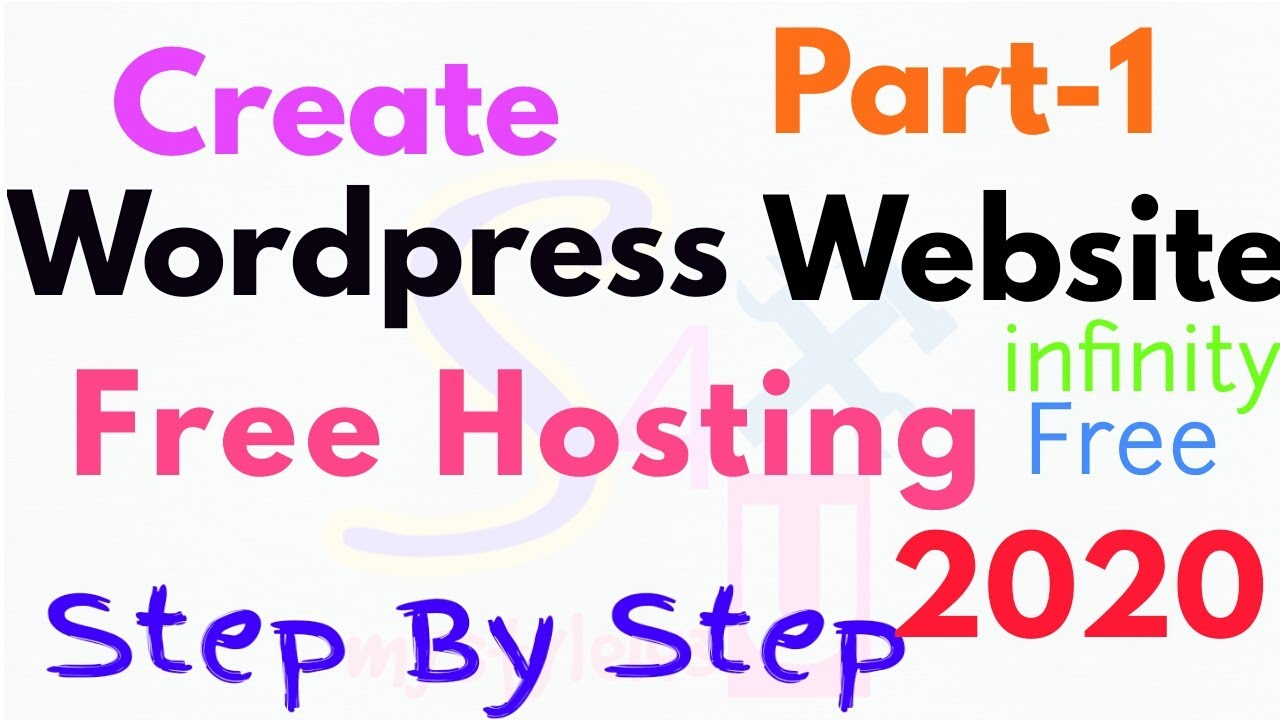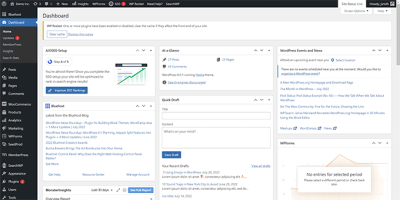If you’re looking to start a website with WordPress but don’t want to spend a fortune on hosting, InfinityFree might just be the solution you’re after. It offers free hosting with a surprisingly decent set of features, making it a popular choice for beginners and hobbyists alike. One of the big questions people have is whether you can run WordPress smoothly on a free hosting service, and the answer is yes—InfinityFree is compatible with
Key Features and Limitations of InfinityFree Hosting

InfinityFree provides a range of features that make it attractive for those wanting free web hosting. Here’s a quick overview:
- Unlimited Disk Space: Yes, you read that right. InfinityFree claims to offer unlimited disk space, which is great for hosting media-heavy websites or multiple projects.
- Bandwidth: They also advertise unlimited bandwidth, allowing your site to handle a fair amount of traffic without extra charges.
- Free SSL Certificates: Security is essential, and InfinityFree provides free SSL certificates, helping your website stay secure and trustworthy.
- One-Click WordPress Installation: Setting up WordPress is straightforward thanks to their one-click installer, saving you time and effort.
- FTP Access and Control Panel: You get access to FTP for file management and a control panel to handle your hosting environment easily.
However, it’s important to be aware of some limitations that come with free hosting:
- Server Reliability and Uptime: Free hosting providers often have less reliable servers, which can lead to downtime. Expect occasional outages or slower load times.
- Resource Restrictions: While they advertise unlimited resources, there are often hidden limits on CPU usage, concurrent processes, or database connections, which can impact your site’s performance under heavy traffic.
- Support and Customer Service: Support options are usually limited. If you encounter issues, troubleshooting might fall on your shoulders, and response times can be slow.
- Advertisements: InfinityFree generally does not display ads on your site, but their branding might appear elsewhere or in your control panel, which some users find a minor inconvenience.
- File Size and Email: There are restrictions on file sizes and no built-in email hosting, so if you need custom email addresses, you’ll have to set up external solutions.
In summary, InfinityFree offers a compelling set of features for free hosting and works well with WordPress, but it’s not without limitations. If you’re just starting out or running a small, low-traffic site, it could be a good fit. For more serious or high-traffic websites, you might want to consider upgrading to a paid plan or exploring other hosting options down the line.
3. Steps to Install WordPress on InfinityFree Hosting
Getting WordPress up and running on InfinityFree hosting is pretty straightforward, even if you’re a beginner. Let’s walk through the steps so you can have your website live in no time!
Step 1: Sign Up for InfinityFree
First things first, head over to the InfinityFree website and create a free account. The sign-up process is quick — just provide your email, create a password, and verify your account through the email link they send.
Step 2: Create a New Hosting Account
Once logged in, go to your dashboard and click on “Create Account.” Fill in your desired domain or subdomain (InfinityFree offers free subdomains if you don’t have your own domain yet). Choose a username and password for your control panel, then click “Create.”
Step 3: Access Your Control Panel
After the account is set up, click on it to access the cPanel-like control panel. Here, you’ll find tools to manage your files, databases, and more. To install WordPress, you’ll mainly need the “Softaculous Apps Installer” or similar script installer, which makes the process super simple.
Step 4: Install WordPress
- Locate the “Softaculous” or “Auto Installer” icon in your control panel.
- Click on it and find the WordPress icon among the available scripts.
- Click “Install” and fill out the form:
- Choose Protocol: http or https (if you have SSL set up).
- Domain: Select your domain or subdomain.
- Directory: Leave blank if you want WordPress installed at the root.
- Site Name & Description: Enter your website’s name and a brief description.
- Admin Username & Password: Pick a secure username and password for login.
- Email: Your contact email.
Once you’ve filled out all the details, click “Install.” The installer will set up WordPress automatically. After a few moments, you’ll get a confirmation message with your website URL and admin login details.
Step 5: Log In and Customize
Now, visit your website URL and add “/wp-admin” at the end to access the login page. Enter the admin credentials you set up earlier, and you’re in! From here, you can choose themes, install plugins, and start building your site.
And that’s it! Installing WordPress on InfinityFree is designed to be user-friendly, even if you’re new to web hosting. Just follow these steps, and you’ll have your site live in no time.
4. Performance and Reliability Considerations
While InfinityFree is a fantastic option for hosting your WordPress site for free, it’s essential to understand some of the performance and reliability factors involved. Knowing what to expect helps you make smarter decisions and plan accordingly.
Performance Aspects
- Server Resources: InfinityFree provides limited CPU, RAM, and bandwidth. This means your site might slow down during traffic spikes or if you use many resource-heavy plugins or themes.
- Speed Optimization: To keep your site running smoothly, consider optimizing images, using caching plugins, and choosing lightweight themes. These small tweaks can significantly improve load times.
- Content Delivery Network (CDN): Using a free CDN like Cloudflare can help distribute your content faster globally, reducing latency and improving user experience.
Reliability and Uptime
- Uptime Expectations: Since InfinityFree offers free hosting, occasional downtime is possible. Their servers are generally stable, but free plans often have less priority compared to paid hosting providers.
- Server Stability: Most users report decent uptime, but sometimes servers may experience overloads or maintenance, leading to temporary outages.
- Backup and Security: InfinityFree doesn’t automatically provide daily backups, so it’s wise to create your own regular backups of your website and database. Also, ensure you keep WordPress and plugins updated to reduce security vulnerabilities.
Additional Tips for Better Performance
- Use a minimal, optimized theme to reduce load times.
- Limit the number of plugins — more isn’t always better!
- Enable caching with plugins like W3 Total Cache or WP Super Cache.
- Regularly monitor your site’s performance using tools like Google PageSpeed Insights or GTmetrix.
In a nutshell, while InfinityFree is a great starting point for hobby projects, learning, or testing ideas, it might not be suitable for high-traffic or business-critical websites. For those, consider upgrading to paid hosting options that offer better resources, support, and uptime guarantees.
By understanding these considerations, you can make the most out of your free hosting experience and ensure your WordPress site performs well and stays reliable as your audience grows.
5. Pros and Cons of Using InfinityFree Hosting for WordPress Sites
Deciding on the right hosting provider for your WordPress site can feel overwhelming, especially with so many options out there. If you’re considering InfinityFree, it’s helpful to weigh the benefits and drawbacks to see if it fits your needs.
Pros of Using InfinityFree Hosting
- Cost-Effective: As a free hosting provider, InfinityFree offers a budget-friendly way to get your WordPress site up and running without any upfront costs. Perfect for beginners, hobby sites, or testing ideas.
- Unlimited Features: Unlike many free hosts with strict limits, InfinityFree claims to offer unlimited disk space and bandwidth, which means you can grow your site without worrying about hitting a cap.
- Easy Setup: With one-click WordPress installation, getting your site live is straightforward, even if you’re new to web hosting.
- Free SSL Certificates: Security is essential, and InfinityFree provides free SSL certificates, helping make your site safer and more trustworthy for visitors.
- Community Support: While not always as extensive as premium hosts, InfinityFree has a community forum where you can get help and share tips.
Cons of Using InfinityFree Hosting
- Limited Support: Since it’s a free service, customer support can be limited or slow, which might be frustrating if you encounter technical issues.
- Performance Variability: Free hosting often means shared resources, so your site’s speed and uptime may fluctuate, especially during peak times.
- Restrictions and Limitations: Despite claims of unlimited features, there are restrictions on CPU usage, file sizes, and resource consumption, which could impact larger or more complex sites.
- No Backup Service: Regular backups are essential for any website, and InfinityFree does not include automatic backups, so you’ll need to manage backups yourself.
- Potential for Ads or Limitations on Customization: Some free hosting environments may display ads or restrict certain customizations, although InfinityFree is relatively ad-free.
In summary, InfinityFree can be a good starting point if you’re just experimenting or learning WordPress without wanting to invest money upfront. However, for a professional or growing website, you might encounter limitations that could hinder your site’s development, making it worth exploring other options down the line.
6. Alternative Hosting Options for WordPress Users
While InfinityFree offers a free and easy way to start, there are plenty of other hosting options suited to different needs and budgets. Let’s explore some popular alternatives that might be better suited as your site grows or if you need more reliable performance.
Shared Hosting
This is the most common and affordable hosting type, where multiple websites share the same server resources. Examples include Bluehost, SiteGround, and DreamHost. They often come with:
- Affordable pricing
- Good customer support
- One-click WordPress installs
Shared hosting is perfect for small to medium websites and beginners. It balances cost and performance well, with the added benefit of more reliable support and features tailored to WordPress.
Managed WordPress Hosting
If you want a hassle-free experience, managed WordPress hosting providers like WP Engine, Kinsta, or Flywheel handle technical details such as updates, backups, and security. Benefits include:
- Optimized performance for WordPress
- Automatic backups and security patches
- Expert support specifically for WordPress issues
While more expensive than shared hosting, this option is ideal for those who want a high-performing, secure, and maintenance-free site.
VPS Hosting
Virtual Private Server (VPS) hosting gives you dedicated resources on a shared server, offering more control and better performance. Providers like InMotion Hosting and Linode are popular choices. Use VPS if:
- You need more resources
- You want custom server configurations
- You have technical expertise or a developer to manage the server
Cloud Hosting
Platforms like Google Cloud, AWS, or DigitalOcean provide scalable cloud hosting solutions. They’re flexible and powerful but require some technical knowledge to set up and manage. Cloud hosting is great for:
- High traffic sites
- Custom application hosting
- Scalable, on-demand resources
Choosing the Right Hosting for Your WordPress Site
When selecting an alternative hosting option, consider these factors:
| Factor | Recommended Hosting Type |
|---|---|
| Budget | Shared Hosting |
| Performance & Maintenance | Managed WordPress Hosting |
| Control & Customization | VPS or Cloud Hosting |
| Traffic Volume | VPS or Cloud Hosting |
| Technical Expertise | Shared or Managed Hosting |
Ultimately, the best hosting choice depends on your specific needs, budget, and technical skills. Starting with a reputable shared hosting provider is often a smart move, and as your site grows, you can consider upgrading to managed or cloud hosting for better performance and scalability.
Final Tips for Setting Up WordPress on Free Hosting Platforms
While using free hosting platforms like InfinityFree to run your WordPress website can be a great way to start without upfront costs, there are several important tips to ensure a smooth setup and optimal performance. First, always choose a strong and unique password for your WordPress admin account to protect your site from security threats. Enable two-factor authentication if available for an added layer of security.
Next, optimize your website’s performance by selecting a lightweight, well-coded theme and limiting the number of plugins installed to only those essential for your site’s functionality. Regularly update WordPress core, themes, and plugins to patch security vulnerabilities and improve stability. Since free hosting often comes with bandwidth and storage limitations, be mindful of your content size and media uploads. Compress images and use caching plugins to reduce load times.
Additionally, back up your site frequently. Many free hosting services offer limited backup options, so consider using a backup plugin that stores copies in external locations like cloud storage services. Keep an eye on your site’s uptime and performance using free monitoring tools to address issues promptly. Lastly, engage with community forums and support channels specific to InfinityFree or WordPress; these resources can provide valuable advice and troubleshooting help.
By following these final tips, you can maximize your free hosting experience, maintain a secure and efficient WordPress site, and set a solid foundation for future growth. Remember, while free hosting has its limitations, careful management and regular maintenance can ensure your website remains functional and accessible to your visitors.


